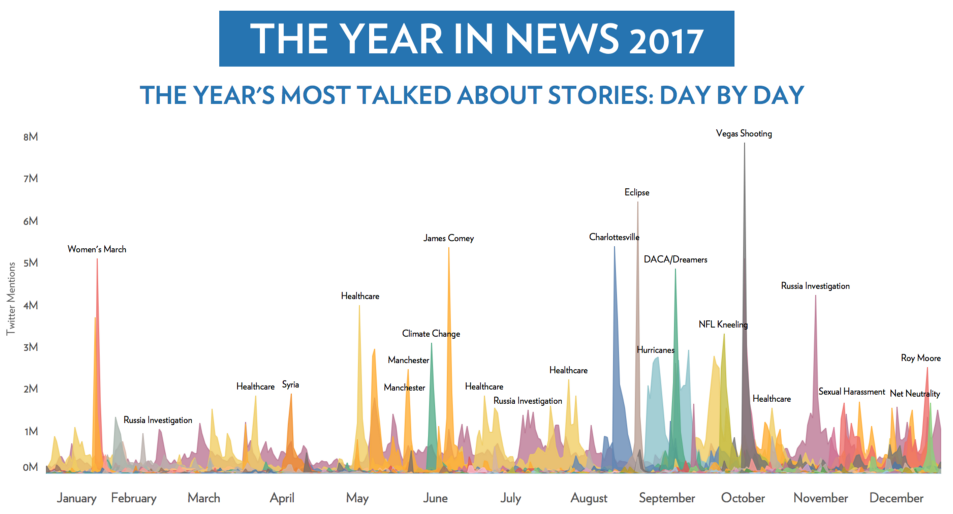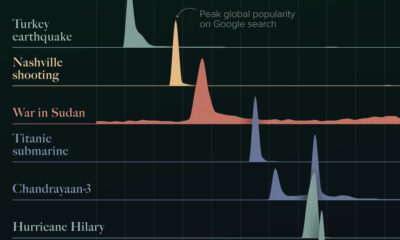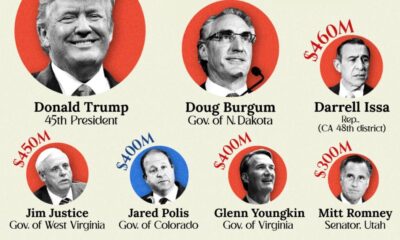Politics
The Year in News 2017, According to 2.8 Billion Tweets

The Year in News 2017, According to 2.8 Billion Tweets
One incredible thing about the big data era is that it allows us to crunch the numbers on pretty much anything.
Whether it’s analyzing a database of 50 million chess moves made during actual tournament gameplay, or developing a deep learning AI that sifts through billions of sensor inputs to learn how to drive a car with full autonomy – we can power nearly any analysis or algorithm with mountains of data.
Like the above examples, today’s infographic from Echelon Insights uses massive amounts of data to paint a picture of the news that wasn’t possible 10 or 20 years ago. By analyzing the words in over 2.8 billion tweets, the end result is a convincing set of visualizations that showcase the most talked about topics over the course of 2017.
The Talk of 2017
Not surprisingly, the conversation in 2017 on Twitter revolved mainly around one person – and you may have heard of him.
I love Twitter…. it's like owning your own newspaper— without the losses.
— Donald J. Trump (@realDonaldTrump) November 10, 2012
According to Echelon Insights, Trump was mentioned 901.8 million times on Twitter in the United States over the duration of the year.
Here’s how that compares to some other notable politicians:
| Politician | Mentions in 2017 |
|---|---|
| Donald Trump | 901.8 million |
| Barack Obama | 164.2 million |
| Hillary Clinton | 123.2 million |
| Bernie Sanders | 48.8 million |
| Mike Pence | 31.4 million |
Trump was mentioned about 30x more often than his VP, and 7x more often than his one-time election opponent, Hillary Clinton.
And incredibly, Trump was the number one topic of daily conversation for 95% of the year, above every other issue and topic:
There were only 17 days in 2017 where Donald Trump was NOT the top topic of conversation, and he was the #1 story every week for every audience
– Echelon Insights, The Year in News 2017
But putting Trump aside, here are the specific narratives that received the most attention by users in the U.S. Twitterverse.
| Topic | Mentions in 2017 |
|---|---|
| Russia investigation | 180.4 million |
| Healthcare & Obamacare | 151.6 million |
| Immigration | 48.0 million |
| Hurricanes | 43.2 million |
| James Comey | 41.8 million |
| Sexual harassment scandals | 36.6 million |
| China | 36.2 million |
| Climate change & Paris Agreement | 31.8 million |
| North Korea | 28.2 million |
The Russia story dominated headlines on an ongoing basis.
The alleged collusion was a constant in the news cycle from February until August, and then it picked up again in November.
It was also the top story for two of the major groups that Echelon Insights tracks, the “Liberal Base”, as well as the “Conservative Base”. However, Russia was only the second most important story for the group “Beltway Elites”, falling behind the much-discussed topic of healthcare.
United States
Charted: What Southeast Asia Thinks About China & the U.S.
A significant share of respondents from an ASEAN-focused survey are not happy about rising American and Chinese influence in the region.

What Southeast Asia Thinks About China & the U.S.
This was originally posted on our Voronoi app. Download the app for free on iOS or Android and discover incredible data-driven charts from a variety of trusted sources.
This chart visualizes the results of a 2024 survey conducted by the ASEAN Studies Centre at the ISEAS-Yusof Ishak Institute. Nearly 2,000 respondents were asked if they were worried or welcoming of rising Chinese and American geopolitical influence in their country.
The countries surveyed all belong to the Association of Southeast Asian Nations (ASEAN), a political and economic union of 10 states in Southeast Asia.
Feelings Towards China
On average, a significant share of respondents from all 10 countries are worried about rising influence from both the U.S. and China.
However, overall skepticism is higher for China, at 74% (versus 59% for U.S.).
| Country | Worried About Growing 🇨🇳 Influence | Welcome Growing 🇨🇳 Influence |
|---|---|---|
| 🇧🇳 Brunei | 58% | 42% |
| 🇰🇭 Cambodia | 66% | 34% |
| 🇮🇩 Indonesia | 57% | 43% |
| 🇱🇦 Laos | 68% | 32% |
| 🇲🇾 Malaysia | 56% | 44% |
| 🇲🇲 Myanmar | 95% | 5% |
| 🇵🇭 Philippines | 81% | 19% |
| 🇸🇬 Singapore | 74% | 26% |
| 🇹🇭 Thailand | 84% | 16% |
| 🇻🇳 Vietnam | 96% | 4% |
| Average | 74% | 27% |
The recently-cooled but still active territorial concerns over the South China Sea may play a significant role in these responses, especially in countries which are also claimants over the sea.
For example, in Vietnam over 95% of respondents said they were worried about China’s growing influence.
Feelings Towards America
Conversely, rising American influence is welcomed in two countries with competing claims in the South China Sea, the Philippines (69%) and Vietnam (55%).
| Country | Worried About Growing 🇺🇸 Influence | Welcome Growing 🇺🇸 Influence |
|---|---|---|
| 🇧🇳 Brunei | 73% | 27% |
| 🇰🇭 Cambodia | 58% | 42% |
| 🇮🇩 Indonesia | 73% | 27% |
| 🇱🇦 Laos | 79% | 21% |
| 🇲🇾 Malaysia | 68% | 32% |
| 🇲🇲 Myanmar | 45% | 55% |
| 🇵🇭 Philippines | 32% | 69% |
| 🇸🇬 Singapore | 37% | 63% |
| 🇹🇭 Thailand | 80% | 20% |
| 🇻🇳 Vietnam | 45% | 55% |
| Average | 59% | 41% |
Despite this, on a regional average, more respondents worry about growing American influence (59%) than they welcome it (41%).
Interestingly, it seems almost every ASEAN nation has a clear preference for one superpower over the other.
The only exception is Thailand, where those surveyed were not a fan of either option, with 84% worried about China, and 80% worried about the U.S.
-

 Money7 days ago
Money7 days agoCharted: Which Country Has the Most Billionaires in 2024?
-

 Energy2 weeks ago
Energy2 weeks agoRanked: The Top 10 EV Battery Manufacturers in 2023
-

 Countries2 weeks ago
Countries2 weeks agoCountries With the Largest Happiness Gains Since 2010
-

 Economy2 weeks ago
Economy2 weeks agoVC+: Get Our Key Takeaways From the IMF’s World Economic Outlook
-

 Demographics2 weeks ago
Demographics2 weeks agoThe Countries That Have Become Sadder Since 2010
-

 Money2 weeks ago
Money2 weeks agoCharted: Who Has Savings in This Economy?
-

 Technology2 weeks ago
Technology2 weeks agoVisualizing AI Patents by Country
-

 Economy2 weeks ago
Economy2 weeks agoEconomic Growth Forecasts for G7 and BRICS Countries in 2024















